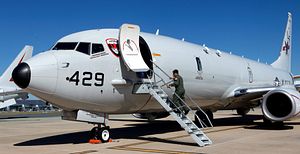U.S. aircraft manufacturer Boeing was awarded a $100 million contract modification for the construction of four P-8A Poseidon maritime patrol aircraft, the U.S. Department of Defense announced on July 19.
“This modification provides for long-lead parts and efforts associated with the manufacture of four full-rate production Lot 8 P-8A Multi-mission Maritime Aircraft for the government of Australia under a cooperative engagement agreement,” the press release notes.
The expected completion date for the four aircraft is June 2017. In January 2016, the U.S. Navy awarded Boeing a $2.5 billion contract for the construction of 20 new P-8A Poseidon maritime patrol aircraft. Included in the contract are the first four P-8As for the Royal Australian Air Force (RAAF).
The RAAF is expected to induct a total of 15 P-8A Poseidon aircraft in two tranches by the late 2020s. The cost for the first tranche of eight aircraft, including the cost of support facilities, is estimated at AU$4 billion ($3.6 billion).
The first eight P-8A are expected to achieve initial operating capability beginning in 2017 and full operating capability by 2021. As I reported elsewhere (See: “Australia’s First New Anti-Submarine Warfare Plane Completes Maiden Flight”):
The P-8A Poseidon is a military variant of Boeing’s Next-Generation 737-800 commercial airplane equipped with advanced anti-submarine, anti-surface warfare and intelligence, surveillance, and reconnaissance capabilities. (…)
The aircraft has an internal fuel capacity of 34 tons providing it with a maximum range of 7,242 kilometers (4,500 miles) without refueling.
Boeing also claims that the aircraft can carry 30 percent more sonobuoys and possess twice the sonobuoy processing capability than any other anti-submarine warfare aircraft currently in service.
The P-8A is capable of remaining “on station conducting low level Anti Submarine Warfare (ASW) missions for over four hours at a range of more than 1,200 nautical miles (2,200 km) from base,” according to the RAAF website. “The P-8A has 11 weapon hard points (five in the bomb bay, four under the wings and two under the fuselage) and can carry over 22,000 pounds (10,000kg) of weapons.”
“Like the Orion, the P-8A has advanced sensors and mission systems. These include an advanced multi-mode radar, a high definition electro-optic camera, an acoustic system (that has four times the processing capacity of the current AP-3C Orion’s system) and an advanced electronic support system that is a derivative of the system fitted to the EA-18G Growler.”
Canberra first announced its intention to procure P-8A aircraft in February 2014 as a replacement for the RAAF’s 15 Lockheed AP-3C Orion maritime patrol aircraft currently in service. Australia’s defense spending will increase from AU$32.4 (US$23.07) billion in fiscal year 2016-17 to A$58.7 (US$41.08) billion in 2025-26, according to the 2016 Defense White Paper (See: “Australia’s Defense Budget to Jump 81 % Over Next Decade”).

































